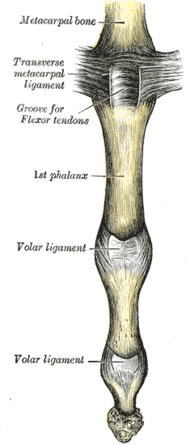Interphalangeal articulations of hand
| Interphalangeal joints of the hand | |
|---|---|

Human hand bones
|
|

Metacarpophalangeal joint and joints of digit. Volar aspect.
|
|
| Details | |
| Identifiers | |
| Latin | articulationes interphalangeae manus, articulationes digitorum manus |
| Dorlands /Elsevier |
a_64/12161327 |
| TA | A03.5.11.601 |
| FMA | 35285 |
|
Anatomical terminology
[]
|
|
The interphalangeal joints of the hand are the hinge joints between the phalanges of the hand (i.e. the finger bones).
There are two sets (except in the thumb):
Anatomically, the proximal and distal interphalangeal joints are very similar. There are some minor differences in how the volar plates are attached proximally and in the segmentation of the flexor tendon sheath, but the major differences are the smaller dimension and reduced mobility of the distal joint.
The PIP joint exhibits great lateral stability. Its transverse diameter is greater than its antero-posterior diameter and its thick collateral ligaments are tight in all positions during flexion, contrary to those in the metacarpophalangeal joint.
The capsule, extensor tendon, and skin are very thin and lax dorsally, allowing for both phalanx bones to flex more than 100° until the base of the middle phalanx makes contact with the condylar notch of the proximal phalanx.
At the level of the PIP joint the extensor mechanism splits into three bands. The central slip attaches to the dorsal tubercle of the middle phalanx near the PIP joint. The pair of lateral bands, to which contribute the extensor tendons, continue past the PIP joint dorsally to the joint axis. These three bands are united by a transverse retinacular ligament, which runs from the palmar border of the lateral band to the flexor sheath at the level of the joint and which prevents dorsal displacement of that lateral band. On the palmar side of the joint axis of motion, lies the oblique retinacular ligament [of Landsmeer] which stretches from the flexor sheath over the proximal phalanx to the terminal extensor tendon. In extension, the oblique ligament prevents passive DIP flexion and PIP hyperextension as it tightens and pulls the terminal extensor tendon proximally.
In contrast, on the palmar side, a thick ligament prevents hyperextension. The distal part of the volar ligament, called the volar plate, is 2 to 3 millimetres (0.079 to 0.118 in) thick and has a fibrocartilaginous structure. The presence of chondroitin and keratan sulfate in the dorsal and volar plates is important in resisting compression forces against the condyles of the proximal phalanx. Together these structures protect the tendons passing in front and behind the joint. These tendons can sustain traction forces thanks to their collagen fibers.
...
Wikipedia
